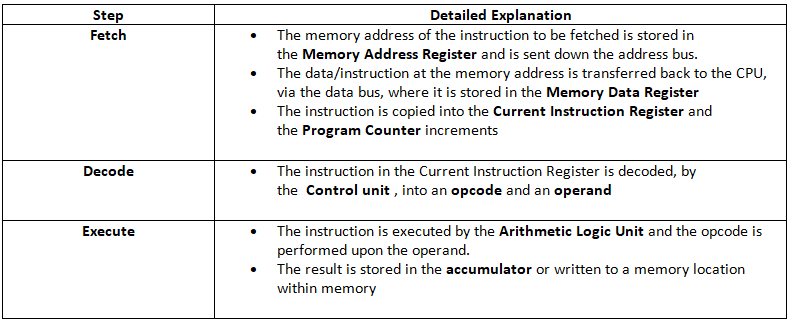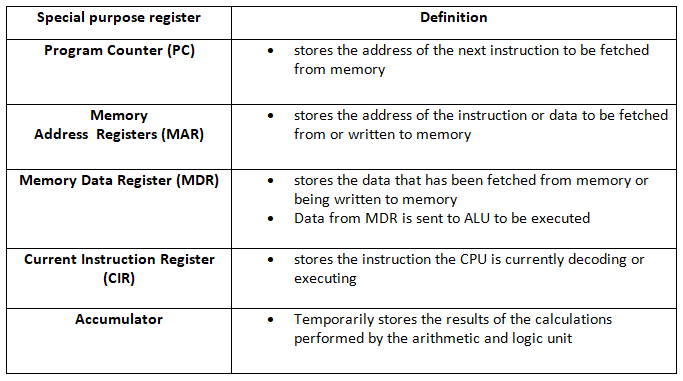Year 11 Exam > Year 11 Notes > Computer for GCSE/IGCSE > Von Neumann Architecture
Von Neumann Architecture | Computer for GCSE/IGCSE - Year 11 PDF Download
The components in a CPU, in a computer that has a Von Neumann architecture
- In the 1940s, John Von Neumann pioneered the concept of the stored program computer.
- The Von Neumann computer architecture, utilized by most modern computers, is founded on this concept.
- Central to the stored program concept and Von Neumann architecture is the storage of both data and instructions in the same memory (RAM) as binary.
- Another hallmark of Von Neumann architecture is the central processing unit (CPU) fetching instructions from memory and executing them sequentially.
- Subsequently, the CPU stores the results back into memory.
Components of the Central Processing Unit

- The primary function of the CPU is to carry out instructions and handle data.
- The CPU comprises two key units: the Control Unit (CU) and the Arithmetic Logic Unit (ALU).
- The Control Unit manages data flow within the CPU and issues control signals to various components for operations like reading, writing, and arithmetic calculations.
- It interprets instructions, controls operation timing (clock speed), and decodes instructions into opcode and operand.
- The ALU executes arithmetic operations like addition and subtraction, as well as logical operations including comparison.
- Interim results are stored in the ALU's built-in register before being transferred to the Memory Data Register (MDR).
- The CPU also features several registers, small memory locations that temporarily store data necessary for instruction execution.
- Special-purpose registers have specific functions in executing instructions efficiently.

Buses
- Computers use buses to connect components within the CPU and the wider computer system. Buses are like highways made of wires that allow electronic signals and data to travel.
- The system bus, consisting of the data bus, control bus, and address bus, serves as the main communication pathway in a computer.
- The data bus is bidirectional, facilitating the transmission of data between the CPU and memory or input/output controllers in both directions.
- The address bus carries addresses from the CPU to memory in a unidirectional manner, ensuring addresses flow only from the CPU to memory.
- The control bus conveys control signals from the control unit to various components like memory or input/output controllers. It is bidirectional in nature.
 A diagram showing how the different buses connect the components in a computer system
A diagram showing how the different buses connect the components in a computer system
Question for Von Neumann ArchitectureTry yourself: What is the primary function of the CPU in a computer with Von Neumann architecture?View Solution
The Fetch, Decode, Execute Cycle
The Central Processing Unit (CPU) carries out instructions through the Fetch Decode Execute cycle.
- The CPU retrieves an instruction from memory.
- The instruction is subsequently decoded by the Control Unit into an opcode and an operand.
- Following decoding, the instruction is executed, and the cycle iterates with the next instruction in the sequence.


The document Von Neumann Architecture | Computer for GCSE/IGCSE - Year 11 is a part of the Year 11 Course Computer for GCSE/IGCSE.
All you need of Year 11 at this link: Year 11
|
92 docs|30 tests
|
FAQs on Von Neumann Architecture - Computer for GCSE/IGCSE - Year 11
| 1. What are the main components in a CPU in a computer with a Von Neumann architecture? |  |
Ans. The main components in a CPU in a computer with a Von Neumann architecture include buses and the Fetch, Decode, Execute Cycle.
| 2. What is the role of buses in a CPU in a Von Neumann architecture computer? |  |
Ans. Buses in a CPU help to transfer data and instructions between different components such as the memory, ALU, and control unit.
| 3. What is the Fetch, Decode, Execute Cycle in a Von Neumann architecture computer? |  |
Ans. The Fetch, Decode, Execute Cycle is the process by which the CPU retrieves instructions from memory, decodes them, and then executes them to perform tasks.
| 4. How does the Von Neumann architecture differ from other computer architectures? |  |
Ans. The Von Neumann architecture differs from other architectures by having a single shared memory for both data and instructions, as well as using a sequential execution of instructions.
| 5. Why is the Von Neumann architecture still widely used in modern computers? |  |
Ans. The Von Neumann architecture is still widely used in modern computers due to its simplicity, efficiency in executing sequential instructions, and flexibility in handling various tasks.

|
Explore Courses for Year 11 exam
|

|
Signup for Free!
Signup to see your scores go up within 7 days! Learn & Practice with 1000+ FREE Notes, Videos & Tests.
Related Searches

















